Since its creation in 1958, NASA has become the world's premier agent for exploration in the "new ocean" of outer space. In just 50 years mankind's physical boundaries have been pushed from the Moon, to Mars and beyond. Ascension Island, for many years home to the NASA facility shown on the FDC, is celebrating NASA's 50th Anniversary with the release of 6 stamps depicting landmark events and craft from each of the 6 decades of NASA's existence. Each value is set within a pictorial border design with a complimentary image from the same decade.1950's Border - Pioneer 4
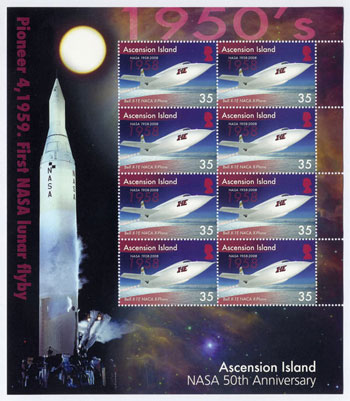
The Pioneer series of spacecraft performed first-of-their-kind explorations of the Sun, Jupiter, Saturn and Venus paving the way for later exploration. Following the unsuccessful rocket launches of Pioneer 0, 1 and 2, NASA had partial success with Pioneer 3. Finally Pioneer 4 achieved its mission objectives. Carrying two Geiger counters to detect cosmic radiation and a camera trigger mechanism experiment, it was the first American spacecraft to escape Earth's gravitational pull. It passed within 58,983 km of the moon, several weeks after the Soviet Union's Luna 1.
35p X-Planes
After the end of the Second World War the US Air Force and NACA (National Advisory Committee on Aeronautics) began the first of a series of experimental aircraft projects, many of which were designed to develop technology for high-speed flight. These soon became known as X-planes and were equipped with multiple recording instruments. They were significant as they were intended to develop technology rather than to lead to operational aircraft. The X-planes were the first crewed and rocket powered vehicles to break the sound barrier (1947).
A second generation of X-planes broke both speed (Mach 2.44) and altitude (90,440 ft) records. Bell X-1E first flew in December 1955. It became one of the fastest and highest flying of the series, achieving a speed of Mach 2.24 and an altitude of 73,458ft. Launched from a Boeing B-29 mother ship it was powered by a 4 chamber rocket engine. With no throttle, speed was varied by igniting combination of different rockets. The X-1 program was completed in 1958 and its impact on aviation history was considerable. X1-E successfully completed its final (26th) flight in November 1958 and is now preserved at Edwards Air Force Base.
1960's Border - Gemini 4
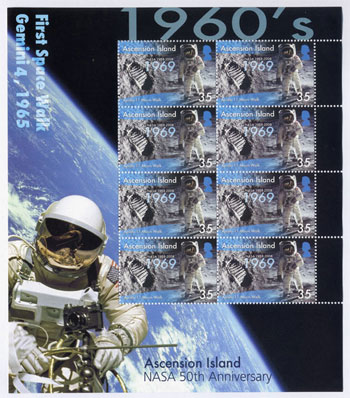
The Gemini program was designed as a bridge between the Mercury and Apollo programs, primarily to test equipment and mission procedures in Earth orbit and to train astronauts and ground crews for future Apollo missions. Each Gemini mission carried two astronauts into Earth orbit for periods ranging from 5 hours to 14 days. The highlight of the Gemini 4 mission was the first space walk by an American, during which Ed White remained outside the spacecraft tied to a tether for 22 minutes. After 15 minutes 40 seconds White was instructed by Houston to reenter the spacecraft. He said, "It's the saddest moment of my life."
35p Moon-Landing
In 1961 President John F Kennedy had challenged NASA to land a man on the moon "and return him safely to earth" before the end of the decade. On 16 July 1969 Apollo 11 achieved lunar orbit and the world held its breath as the lunar module, Eagle, prepared to land. On 20 July 1969 Neil Armstrong became the first astronaut to set foot on the moon with the famous proclamation "That's one small step for a man, one giant leap for mankind." He was soon joined by Buzz Aldrin and the two spent 2 hours on the moon conducting experiments and taking pictures. Alongside the flag they placed a plaque that read "Here men from the planet Earth first set foot upon the Moon July 1969, A.D. We came in peace for all mankind."
1970's Border - Lunar Roving Vehicle (LRV) Apollo 16

Apollo 16 was the tenth manned mission in the Apollo program and the fifth mission to land on the Moon. It was the only one of the six Apollo landings to target the lunar highlands. The scientific results of Apollo 16 caused planetary geologists to revise previous interpretations of the lunar highlands, concluding that meteorite impacts were the dominant agent in shaping the moon's ancient surfaces. The Apollo 16 astronauts also conducted performance tests with the LRV achieving a top speed of eleven miles per hour, which still stands as the record speed for any wheeled vehicle on the Moon.
40p Lunar Roving Vehicle (LRV)
The LRV was a surface exploration rover used on the Moon during the Apollo program (Apollo 15-17). It was an electric vehicle designed to operate in the low-gravity vacuum of the Moon and to be capable of traversing the lunar surface, allowing the Apollo astronauts to extend the range of their surface extravehicular activities. Apollo 17 remains the most recent manned Moon landing and broke several records, including longest manned lunar landing flight and the longest total lunar surface extravehicular activities. Its crew included the only scientist to walk on the moon.
1980's Border - Magellan spacecraft
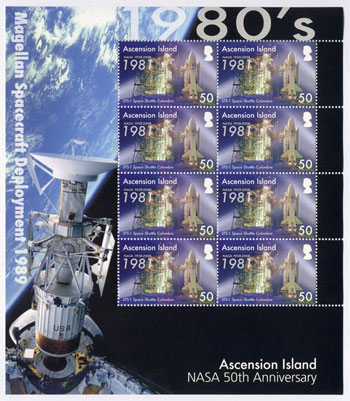
The Magellan spacecraft was a space probe sent to the planet Venus. It was the first deep-space probe to be launched on the Space Shuttle (STS-30) and was also the first spacecraft to employ aerobraking techniques to lower its orbit. Magellan created the first and best near-photographic quality, high resolution mapping of the planet's surface features before plunging to the surface as planned in 1994. Although partly vaporized; some sections are thought to have hit the planet's surface.
50p Space Shuttle STS-1
The Space Shuttle is used by NASA for its human space flight missions carrying astronauts and payloads into low earth orbit. The shuttle was the first orbital spacecraft designed for partial reusability, gliding to achieve a completely unpowered landing. STS-1 was launched 12 April 1981, exactly 20 years after Yuri Gagarin's historic space flight. NASA described the mission as: "The boldest test flight in history" as much could not be tested prior to the launch.
1990's Border - Servicing Hubble
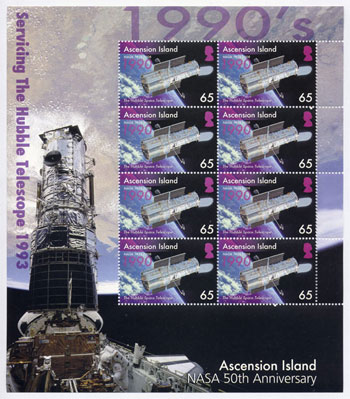
The Hubble is the only telescope ever designed to be serviced in space by astronauts. After the launch scientists found that the main mirror had been ground incorrectly, affecting its capabilities. However, after a highly successful servicing mission in 1993, the telescope was restored to its intended quality. A final servicing mission is expected to allow the telescope to function until at least 2013.
65p Hubble Space Telescope
Collaboration between NASA and the European Space Agency saw The Hubble Space Telescope carried into orbit in 1990 aboard the Space Shuttle. One of the most technologically advanced pieces of equipment that humans have put into orbit, Hubble has been providing scientists and the public with spectacular images of deep space for more than 15 years. Thanks to incredible efforts of scientists and engineers, the telescope has also given astronomers insight into the history and fate of our universe.
2000's Border - International Space Station (ISS)
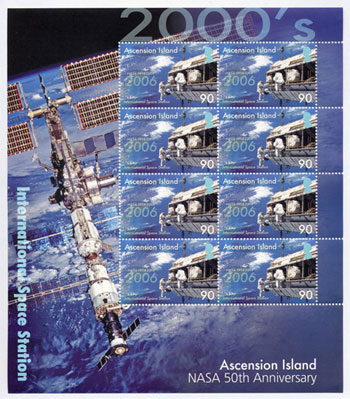
The ISS is a joint project between many countries. The projected completion date is 2010, with the station remaining in operation until around 2016. It is already larger than any previous space station and at an estimated cost of US$157 billion until the program will end in 2017 it is the most expensive object ever built.
90p International Space Station
The ISS is a research facility being assembled in space. It is in a low Earth orbit and can be seen with the naked eye: it has an altitude of approximately 220 miles above the surface of the Earth, and travels at an average speed of 17,210 miles per hour.
First Day Cover

The original purpose of constructing the station at Ascension was for it to support the early Surveyor missions whose Atlas-Centaur launch vehicles would produce a direct-ascent trajectory to the moon, rather than insertion into a parking orbit. Translunar injection would therefore occur before the spacecraft was visible to either the Johannesburg station or the stations in Spain. Consequently a station nearer to the launch site than these facilities was needed to obtain during this phase positional data vital to trajectory determination and midcourse corrections.
Because such a station could also support later deep-space missions and Apollo manned missions, NASA decided to build an integrated facility (with a joint-control building) serving both programmes. A site survey, conducted by Goddard Space Flight Centre personnel in April 1964 on Ascension Island, identified a suitable site at Devil's Ashpit, at an elevation of 1,761 feet on the eastern side of the island.
Deep space and Apollo missions were separately monitored by two 9-metre, az-el-mounted antennas with high angular-tracking rates. The deep-space antenna (on the right) had a nominal communications range of 60,300 kilometres (37,500 miles).




















